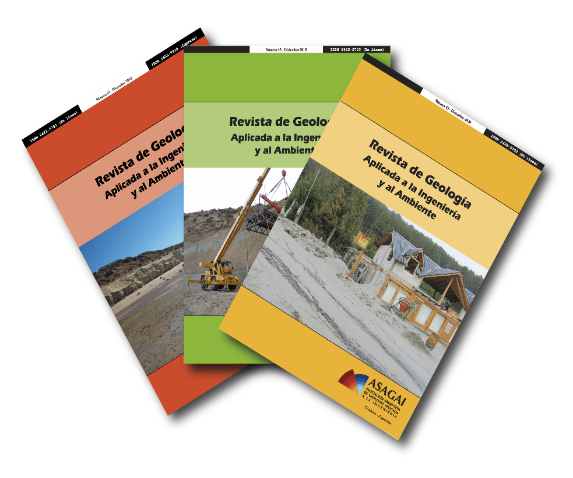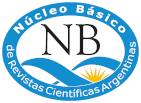Soil amplifying effect on vulnerability to seismic hazard for Tolhuin, Tierra del Fuego, Argentina
DOI:
https://doi.org/10.59069/kqhhyx39Keywords:
RADIUS, seismic risk, building vulnerability, EERAAbstract
The island of Tierra del Fuego (Argentina-Chile) lies in a
region of intense seismic activity due to the interaction of the
Antarctica, Scotia and South American tectonic plates. Two
seismotectonic zones in this region: the subduction trench in
southernmost Chile and the Magallanes-Fagnano fault, that crosses the island from east to west, represent a seismic hazard for the island population. Focusing on the Argentine sector of Tierra del Fuego, however, the greater threat comes from the Magallanes-Fagnano fault, which has generated seismic events in historical times of magnitude M=8. Tolhuin, a small population of 3000 inhabitants undergoing fast growth, is located 1 km from the trace of the Magallanes-Fagnano fault. Buildings in Tolhuin largely have not had seismic safety controls required by the INPRES (the Argentine seismic building code regulator). In addition, the urbanization of Tolhuin rests on a thick package of Quaternary glacigenic sediments with the potential for amplifying seismic vibrations by a factor of more than 2, judging from a simulation with EERA (Equivalent-linear Earthquake Analyses). Applying the Risk Assessment Tools for Diagnosis of Urban Areas against Seismic Disasters (RADIUS) methodology, supported by the United Nations, this study analyses the seismic vulnerability of constructions in Tolhuin under the effect of a Maximum Considered Earthquake of magnitude M=8.0. The results show the importance of considering the probable local amplification through site effects. This study constitutes a first effort to provide the Argentine province of Tierra del Fuego with cartographic and conceptual tools useful in planning urban growth taking into consideration seismic hazard.
References
Abascal, L. del V. y G. González Bonorino, 2008. Seismic risk associated with the Magallanes-Fagnano continental transform fault, Tierra del Fuego, southern Argentina. 7th International Symposium on Andean Geodynamics (ISAG 2008, Nice), Extended Abstracts, p. 13-16.
Andrus, R.D., J. Zhang, B.S. Ellis & C.H. Juang, 2003. Guide for estimating the dynamic properties of South Carolina soils for ground response analysis. South Carolina Department of Transportation, SC-DOT Research Project No. 623, Report N° FHWA-SC-03-07.
Bardet, J.P., K. Ichii & C.H. Lin, 2000. EERA - A computer program for Equivalent-linear Earthquake site Response Analyses of layered soil deposits. Department of Civil Engineering, University of California, Los Angeles, 37 pp.
Barrientos, S.E., 2007. Earthquakes in Chile. En Moreno, T. yW. Gibbons (eds.) The geology of Chile. The Geological Society of London, London, p. 263–289.
Bassin, C., G. Laske & G. Masters, 2000. The current limits of resolution for surface wave tomography in North America. EOS Transactions AGU. Volume 81, F897.
Bradley J.C., Z. Hajnal & A. Prugger, 1998. Shear-wave studies in glacial till. Geophysics. Volume 63: 1273–1284.
Buffoni, C., N.C. Sabbione, G. Connon y J.L. Hormaechea, 2009. Localización de hipocentros y determinaciónde su magnitud en Tierra del Fuego y zonas aledañas. Geoacta. Volume 34:75–86, Buenos Aires.
Caminos, R., 1980. Cordillera fueguina. En Geología regional argentina. Academia Nacional de Ciencias, Córdoba. Volumen 2: 1463-1501.
Campbell, K.W. 1997. Empirical near-source attenuation relationships for horizontal and vertical components of peak ground acceleration, peak ground velocity, and pseudo-absolute acceleration response spectra. Seismological Research Letters. Volumen 68:154-179.
CFI, 1996. Estudio sobre provisión de agua para la Comuna de Tolhuin. Programa de Desarrollo de Pequeñas Comunidades, Consejo Federal de Inversiones, 17 p.
Costa, C.H., R. Smalley, D. Schwartz, H. Stenner, M. Ellis, E. Ahumada & M.S. Velasco, 2006. Preliminary seismological observations at an onshore transform boundary: The Magallanes-Fagnano Fault, Tierra del Fuego. Revista de la Asociación Geológica Argentina. Volumen 61: 647-657, Buenos Aires.
Demets, C., R.G. Gordon & D.F. Argus, 2010. Geologically current plate motions. Geophysical Journal International. Volumen 181:1–80. doi:10.1111/j.1365-246X.2009.04491.x.
DNV, 2004. Informe de Ingeniería, IIIa2. Capítulo 1, Suelos y materiales. Ruta Khamy-Kosobo. Dirección Nacional de Vialidad, 78 p., Buenos Aires
Febrer, J.M., M.P. Plasencia & N.C. Sabbione, 2001. Local and regional seismicity from Ushuaia broadband station observations (Tierra del Fuego). Terra Antartica. Volume 8: 35-40.
FEMA, 2003. NEHRP recommended provisions for seismic regulations for new buildings and other structures (FEMA 450). Part 1: Provisions. National Institute of Building Sciences, 340 pp.
FUNCOR, 1997. Estudio de suelos. Ampliación muelle comercial. Puerto Ushuaia, provincia de Tierra del Fuego. Dirección Provincial de Puertos, 76 p.
González Bonorino, G., V. Rinaldi, L. del V. Abascal, P. Alvarado, G.G. Bujalesky & A. Güell, 2012. Holocene paleoseismicity in southern Patagonia (Argentina-Chile; 52º-55ºS); the role of the Magallanes-Fagnano transform fault. Journal of Natural Hazards. Volume 61: 337-349.
Gregg, P.M., J. Lin & D.K. Smith, 2006. Segmentation of transform systems on the East Pacific Rise: Implications for earthquake processes at fast-slipping oceanic transform faults. Geology. Volumen 34: 289-292.
Instituto Superior de Recursos Hídricos, 1998. Ampliación del puerto de Ushuaia, Tierra del Fuego. Informe Técnico Final, Documento I, Memorias Técnicas, 104 pp. Córdoba.
Jaschek, E., N. Sabbione y P. Sierra, 1982. Reubicación de sismos localizados en territorio argentino (1920–1963). Observatorio Astronómico de la Universidad Nacional de La Plata, Serie Geofísica.Volumen XI, No 1, 79 pp.
Lawrence, J.F. & D.A. Wiens, 2004. Combined receiver-function and surface wave phase-velocity inversion using a niching genetic algorithm: application to Patagonia. Bulletin of the Seismological Society of America. Volumen 94: 977–987.
Lodolo, E., M. Menichetti, R. Bartole, Z. Ben Avraham, A. Tassone & H. Lippai, 2003. Magallanes-Fagnano continental transform fault (Tierra del Fuego, southernmost South America). Tectonics. Volume 22(6), 1076, DOI: 10.1029/2003TC0901500.
Martin, A., 1990. Hacia una nueva regionalización y cálculo de peligro sísmico en Chile. Tesis, Universidad de Chile, Santiago, 207 pp.
Martinic, M., 2008. Registro histórico de antecedentes volcánicos y sísmicos en la Patagonia austral y la Tierra del Fuego. Magallania.Volumen 36: 5–18.
Meglioli, A., 1992. Glacial geology and chronology of southernmost Patagonia and Tierra del Fuego, Argentina and Chile. Tesis. Lehigh University, 216 pp., Nueva York.
Pelayo, A. & D. Wiens, 1989. Seismotectonics and relative plate motions in the Scotia sea region. Journal of Geophysics Research. Volumen 94: 7293–7320.
Reiter, L., 1991. Earthquake hazard analysis. Columbia University Press, 254 pp., Nueva York.
Rosyidi, S.A., K.A.M. Nayan, M.R. Taha & A. Ismail, 2006. Estimating G-max & field CBR of soil subgrade using a seismic method. http://www.NDT.net. Volumen 11, No.6.
Sabbione, N., G. Connon, J.L. Hormaechea y M. Rosa, 2007. Estudio de sismicidad en la provincia de Tierra del fuego, Argentina. Geoacta. Volumen 32: 41-50.
SEGEMAR, 2002. Provincia de Tierra del Fuego – Condiciones geotécnicas. Subárea este del lago Fagnano. http://www.mineria.gov.ar/estudios/irn/tierradelfuego/t-6zona.asp#m2.
Smalley, R., JR., E. Kendrick, M.G. Bevis, I.W.D. Dalziel, F. Taylor, E. Lauría, R. Barriga, G. Casassa, E. Olivero & E. Piana, 2003. Geodetic determination of relative plate motion and crustal deformation across the Scotia-South America plate boundary in eastern Tierra del Fuego. Geochemistry Geophysics Geosystems. Volume 4: 1-19.
Spence, R.J.S., 1990. Seismic risk modeling – A review of methods. Contribution to Verso il New Planning, University of Naples, Papers of Martin Centre for Architectural and Urban studies, 155 pp., Cambridge.
Trifunac, M.D. & A.G. Brady, 1975. On the correlation of seismic intensity scales with the peaks of the recorded ground motion. Bulletin, Seismological Society of America. Volumen 65: 103-145.
West, T.R., 2002. Subsurface investigations of several glacial successions related to engineering construction. Proceedings of the Indiana Academy of Science, Illinois, 15 p.
Winslow, M.A., 1982. The structural evolution of the Magallanes Basin and neotectonics in the southernmost Andes. En Craddock, C. (ed.) Antarctic Geoscience. I.U.G.S., Series B (4): 143-154
Downloads
Published
Issue
Section
License
Copyright (c) 2012 Journal of Engineering Geology and the Environment

This work is licensed under a Creative Commons Attribution-NonCommercial-ShareAlike 4.0 International License.
Attribution - Non-Commercial - Share Alike (by-nc-sa): No commercial use of the original work or any derivative works is permitted, distribution of which must be under a license equal to that governing the original work.










